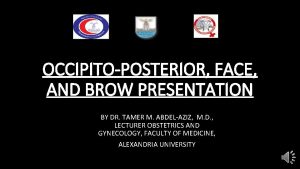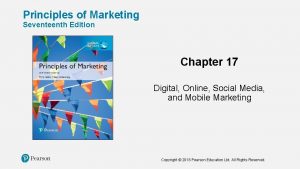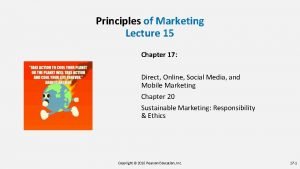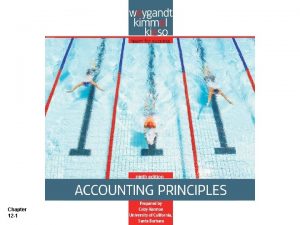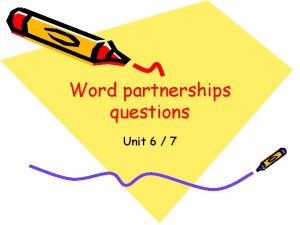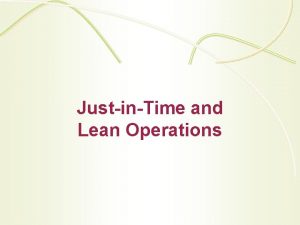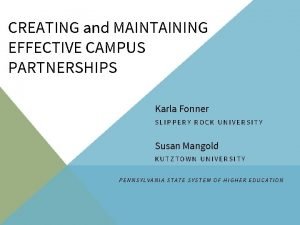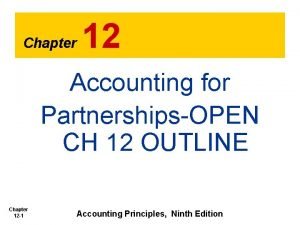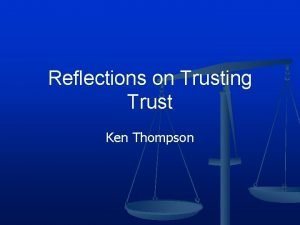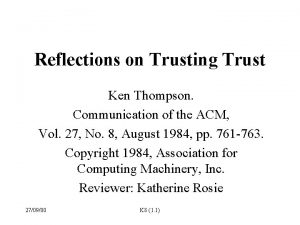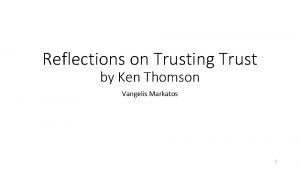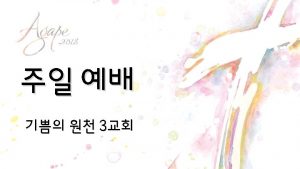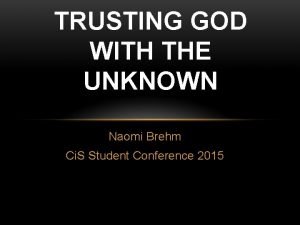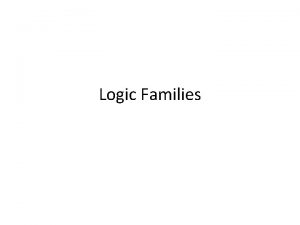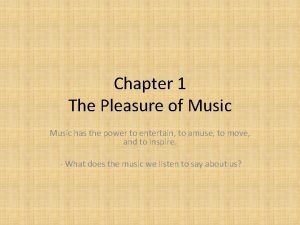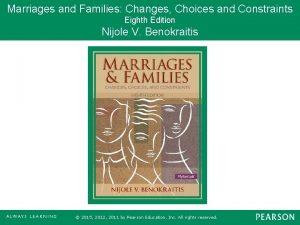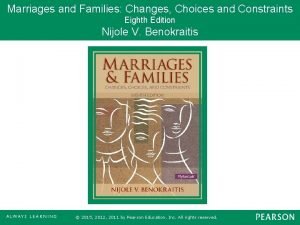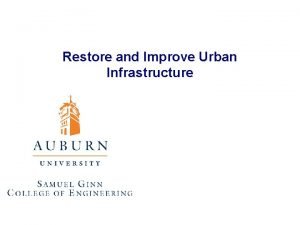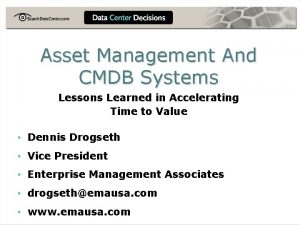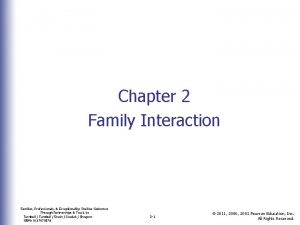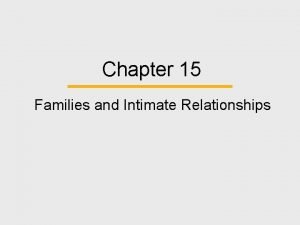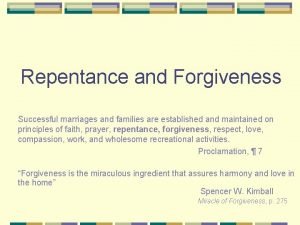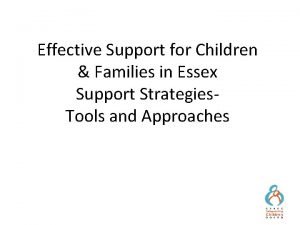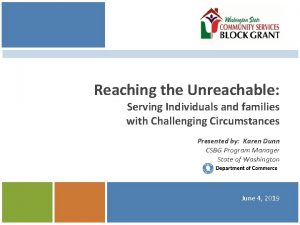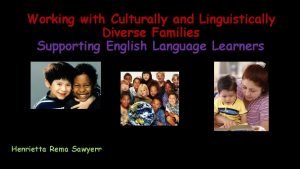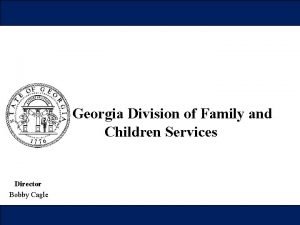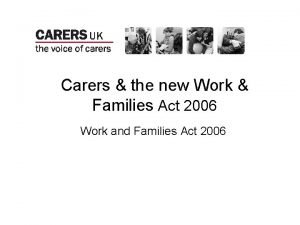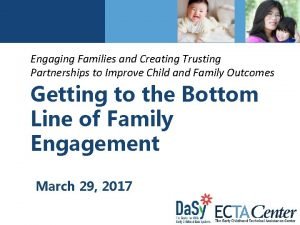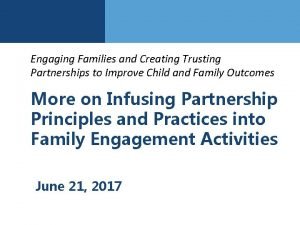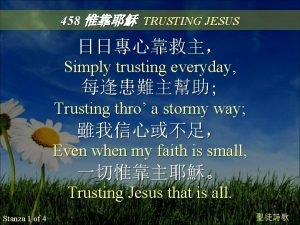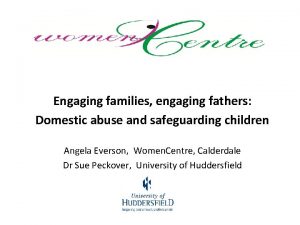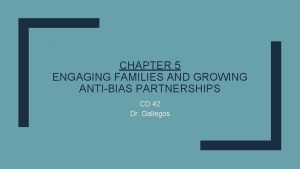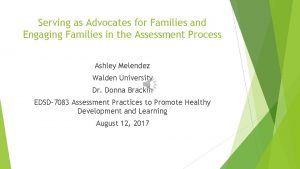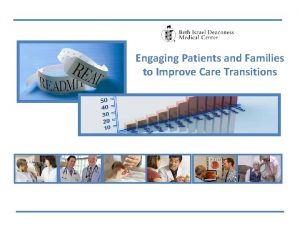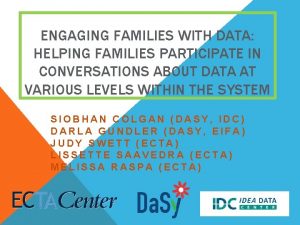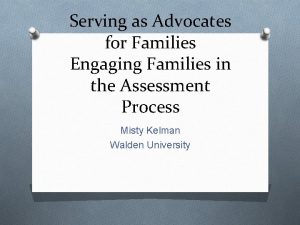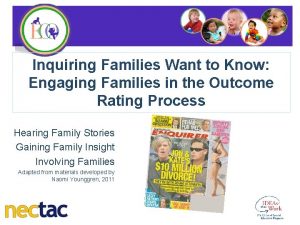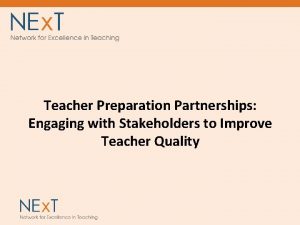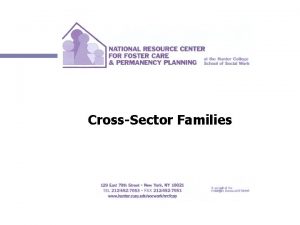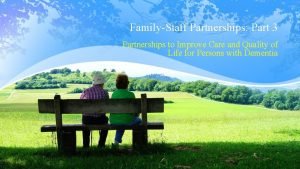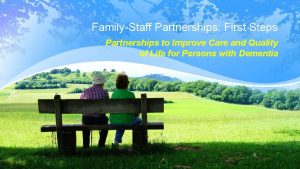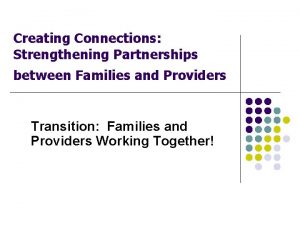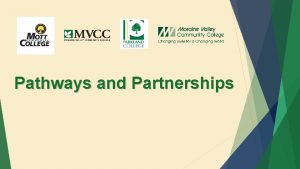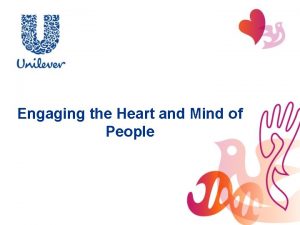Engaging Families and Creating Trusting Partnerships to Improve

















































- Slides: 49

Engaging Families and Creating Trusting Partnerships to Improve Child and Family Outcomes Enhancing Trusting Partnerships at the Systems and Practice Levels: Reciprocal Opportunities for Professionals and Families April 20, 2017

Today’s Presenters/Facilitators • Sherry Franklin, TA Specialist, ECTA/Da. Sy Centers • Ann and Rud Turnbull, Faculty Fellows, UNC/FPG • Dee Gethmann, Part B 619 Coordinator, Iowa Dept. of Education • Alicia Karwal, Family Leader, Iowa’s SPDG Family. Professional Partnership Strand Team • Karen Thompson, Executive Director, ASK Resource Center (Iowa PTI Center) • Brandi Thacker, Director of Training, Technical Assistance, and Collaboration, NCPFCE 2

Today’s Discussion • Principles of trusting partnership • Using national resources to inform and guide program improvement work • Thinking about and planning for measuring familyprofessional partnerships and related practices 3

Facilitator: We focused on the foundation of family engagement in our first webinar. Rud, would you give us a brief re-cap? 4

Bringing it All Together: Bottom Line The bottom line of family engagement is the development of a respectful and trusting partnership. 5

Facilitator: Ann, remind us of your “solar power” characterization of trusting partnerships. 6

7

Facilitator: Ann, I am resonating with your six principles of trusting partnerships. How did you come to the formulation of these six? 8

The Beach Center’s Research on Partnerships • Qualitative research – 33 focus groups and 32 individual interviews • Participants included parents of children with and without disabilities, service providers, administrators • Broad representation of cultural diversity 9

Trusted Research Partners Ursula and DJ Markey Louisiana Community Parent Resource Center 10

Trusting Partnerships: Six Components • Communication • Competence • Respect • Commitment • Equality • Advocacy 11

Facilitator: What were highlights from your research of what families and practitioners shared about the essence of each of these six themes? 12

Communication • Being friendly • Being clear • Highlighting strengths and good news • Being honest, even with bad news • Responding to feelings • Listening 13

Competence • Knowing and implementing evidence-based practices • Setting high expectations and working hard to meet them • Continuing to learn when faced with new challenges 14

Respect • Honoring cultural diversity • Building on strengths • Valuing each other’s perspectives and recommendations • Seeking to “walk a mile” in the others’ shoes 15

Commitment • Being available for communication • Being flexible with using innovative ways to solve challenges • Being sensitive to emotional needs • Going above and beyond 16

Equality • Fostering each other’s confidence • Seeking each other’s input • Creating conditions that lead to a level playing field 17

Advocacy • Expressing viewpoints • Thinking creatively “outside of the box” • Working toward win-win solutions • Speaking up for children, families, practitioners, and system leaders 18

Research on Partnerships • Families from three age groups of children (birth-3, 35, 6 -12) place equal importance on partnerships. Parents of children ages 6 -12 are less satisfied than parents of children 3 -5, who are also less satisfied than parents of children birth-3 (Summers et al. , 2005 b). • Families with low-income rate all the items related to partnership as equally important as compared to middle- and high-income families; but families with low income are significantly less satisfied (Summers et al. , 2005 b). 19

Research on Partnerships (cont. ) • Parents’ satisfaction with partnership significantly predicts parent involvement and parent-teacher communication for families of kindergarten children with and without disabilities (Zuna, 2007). • Families who experience stronger partnerships with educators experience less family stress (Burke & Hodapp, 2014). 20

Research on Partnerships (cont. ) • For families of children (ages birth-21) with deafblindness, both high quality partnership and high quality educational services are needed for family quality of life. The high quality effects of one (partnership or education services) do not buffer the low quality effects of the other (Kyzar et al. , 2015). • Parents of children birth-21 with various types of disabilities, who have higher satisfaction with partnerships, report having higher family quality of life (Kyzar, Brady, Summers, & Turnbull, submitted; Summers et al. , 2007). 21

What’s Missing from the Research? We need research on the impact of partnerships on professional quality of life. 22

“I’ve learned that people will forget what you said, people will forget what you did, but people will never forget how you made them feel. ” -Maya Angelou, American poet 23

Iowa’s Early Childhood Partnership Team 24

Iowa’s Journey • ECTA System Framework: What does Iowa need to put into place to support implementation of effective practices? • ECTA System Framework Self-Assessment – Governance Quality Indicator GV 5: State and regional and/or local system entities are designed to maximize meaningful family engagement in the development and implementation of the system. – Personnel/Workforce Quality Indicator PN 1 a: The composition of the leadership team represents key partners from cross-sector early childhood systems, technical assistance programs, institutions of higher education, parent organizations as well as any other relevant stakeholders across disciplines. 25

Iowa’s Journey • Areas of improvement: – Articulate vision, mission, and guiding principles of system of services for young children with developmental delays and disabilities and their families – Re-establish commitment to family leadership, family engagement, and parent-professional partnerships – Partner to promote an inclusive, integrated early childhood system of services • This takes implementing the principles of trusting partnership! 26

Iowa’s Inclusion Cohort State Team Vision: Every child, beginning at birth, will be healthy and successful. Mission: Design and implement cross-sector system supports, including policies and practices, to ensure young children of all abilities, and their families, experience inclusion across all early childhood settings and services that result in a sense of belonging, partnerships, positive social relationships, friendships, development, and learning to meet the full potential of each and every child. (Adopted from DE/HHS Inclusion Policy Statement, 2014) 27

Iowa’s Inclusion Cohort State Team • • • 28 Parent Training and Information (PTI) Center Head Start Collaboration Office Child Care Administration – Dept. of Human Services Early Childhood Administration – Dept. of Education IDEA Part C – Early Intervention IDEA Part B - Early Childhood Special Education (619) State Prekindergarten/Preschool for 4 -year-olds State At-Risk Preschool Early Childhood Iowa – early care, health, and education system

Inclusion Cohort State Team Goals • Goal 1: Gather, analyze, and use data from key stakeholders, including practitioners, families, and leadership, to identify current challenges and solutions related to inclusion of children, birth to five years of age. • Goal 2: Develop and disseminate a cross-sector policy statement that provides guidance for practitioners, families, and leadership on implementing high-quality inclusive practices across early childhood settings and services. • Communication Plan and Stakeholder Engagement: Ensure effective communication and stakeholder engagement. Resources: US Dept. of HHS DE Policy Statement Inclusion of Children with Disabilities in Early Childhood Programs (2015). Barton & Smith, Preschool Inclusion Toolbox (2015). 29

Iowa’s State Personnel Development Grant (SPDG) • Competitive funding opportunity provided by the U. S. Department of Education • Focused on personnel development within project areas • Focused on a particular topic of set of topics: – Literacy – Specially Designed Instruction (SDI) • PTI Centers are required partners on SPDGs. 30

SPDG Strands • • • 31 Early Childhood Special Education K-6 Significant Disabilities Assistive Technology Family/Professional Partnerships – Family-School-Community Partnerships – “School” or “Educator” or “Professional”

Informing Our Work Epstein’s Framework on Parent Involvement Six Types of Parent Involvement: • Parenting • Communicating • Volunteering • Learning at Home • Decision Making • Collaborating with Community Framework Categories: • Practices • Challenges • Redefinitions • Expected Results 32 U. S. Department of Education’s Dual Capacity Framework for Family-School Partnerships

Depth to working with families Involve Engage Partner RECIPROCAL ● MUTUAL ● EQUAL ● SHARED TO FAMILIES ≠ FOR FAMILIES ≠ WITH FAMILIES 33


Resources on Trusting Partnerships 35

Available at: https: //www. amazon. com/F amilies-Professionals. Exceptionality-Partnerships -Loose. Leaf/dp/0133833682/ref=sr _1_1? ie=UTF 8&qid=14733 48717&sr=81&keywords=family+profes sionals+and+exceptionality 36

CONNECT Online Module on Family-Professional Partnerships 37

Beach Center Family -Professional Partnership Scale • 2 domains – Enhancing Connection – Enhancing Capacity • 18 items 38

Sample Excerpt: Beach Center Family. Professional Partnership Scale 39

PFCE Framework Resources 40

Parent, Family, and Community Engagement (PFCE) Framework Positive & Goal-Oriented Relationships Family Well-being Program Environment Program Leadership Positive Parent-Child Relationships Family Partnerships Continuous Program Improvement Families as Lifelong Educators Children are ready for school and sustain Development and learning gains through third grade Families as Learners Teaching and Learning Professional Development Community Partnerships Family Engagement in Transitions Family Connections to Peers and Community Families as Advocates and Leaders Program Foundations 41 Program Impact Areas Family Outcomes Child Outcomes

Available at: https: //eclkc. ohs. acf. hhs. gov/hslc/ttasystem/family/docs/ building-partnerships -developingrelationshipsfamilies. pdf 42

Available at: https: //eclkc. ohs. acf. hhs. gov/hslc/ttasystem/family/docs/ tracking-progressearly-care-education -long-version. pdf 43

44

Where do we go from here? March 29 th (3 -4 p. m. ET) • Getting to the Bottom Line of Family Engagement 45 Today’s Webinar: April 20 th (3 -4 p. m. ET) • Enhancing Trusting Partnerships at the Systems and Practice Levels: Reciprocal Opportunities for Professionals and Families Next Webinar: May 24 th (3 -4 p. m. ET) • Infusing Partnership Principles and Practices into Family Engagement Activities

The WHAT of Family Engagement: Types of Activities • Meeting families’ basic needs • Referring and evaluating for services and supports • Individualizing in developing and providing services and supports • Extending child’s learning in home and community • Participating and volunteering with program/school • Advocating for systems improvement 46

Online Webinar Resources http: //ectacenter. org/~calls/2017/familyengagement. asp Power. Point Handouts Suggestions for Follow-up Reflection/Discussion Resources and References 47

Register for the Next Webinar! Infusing Partnership Principles and Practices into Family Engagement Activities May 24 th, 3 -4 p. m. ET Register at: http: //ectacenter. org/webinars. asp 48

The contents of this tool and guidance were developed under grants from the U. S. Department of Education, #H 326 P 120002 and #H 373 Z 120002. However, those contents do not necessarily represent the policy of the U. S. Department of Education, and you should not assume endorsement by the Federal Government. Project Officers: Meredith Miceli, Richelle Davis, and Julia Martin Eile. 49
 Little families
Little families Engaging diameter in brow presentation
Engaging diameter in brow presentation Dynamisch verbinden
Dynamisch verbinden Marketing involve engaging directly with carefully targeted
Marketing involve engaging directly with carefully targeted Marketing involve engaging directly with carefully targeted
Marketing involve engaging directly with carefully targeted Accounting for partnerships chapter 12 solutions
Accounting for partnerships chapter 12 solutions Accenture development partners
Accenture development partners Word partnership
Word partnership Product development partnerships
Product development partnerships Jit scheduling tactics
Jit scheduling tactics Maintaining effective partnerships
Maintaining effective partnerships Publicpartnerships.com login
Publicpartnerships.com login Epsrc prosperity partnerships
Epsrc prosperity partnerships Chapter 12 accounting for partnerships answers
Chapter 12 accounting for partnerships answers Ken thompson reflections on trusting trust
Ken thompson reflections on trusting trust Reflecting on trusting trust
Reflecting on trusting trust Reflections on trusting trust
Reflections on trusting trust Organismic trusting
Organismic trusting Trusting god in perilous times
Trusting god in perilous times Trusting god in all circumstances
Trusting god in all circumstances Keep trusting
Keep trusting Naomi brehm
Naomi brehm Characteristics of logic
Characteristics of logic Compare and contrast the bach and marsalis families
Compare and contrast the bach and marsalis families Compare and contrast the bach and marsalis families
Compare and contrast the bach and marsalis families Family of orientation
Family of orientation Marriages and families changes choices and constraints
Marriages and families changes choices and constraints Creating and interpreting graphs and tables
Creating and interpreting graphs and tables Restore and improve urban infrastructure
Restore and improve urban infrastructure How to monitor and improve workplace operations
How to monitor and improve workplace operations Accurate cutting facilitates sewing and improve garment
Accurate cutting facilitates sewing and improve garment Asset management cmdb
Asset management cmdb Protect, promote, and improve the health of all people
Protect, promote, and improve the health of all people Families professionals and exceptionality
Families professionals and exceptionality Define the relationship chapter 15
Define the relationship chapter 15 Ada juke family tree
Ada juke family tree Master of the surprise ending
Master of the surprise ending Successful marriages and families
Successful marriages and families Effective support for children and families in essex
Effective support for children and families in essex Nucleus on the periodic table
Nucleus on the periodic table Chapter 9. voices and instrument families
Chapter 9. voices and instrument families Prop 206 pto
Prop 206 pto Serving individuals and families
Serving individuals and families Serving individuals and families
Serving individuals and families The needs of families and suitability for the local
The needs of families and suitability for the local Working with culturally and linguistically diverse families
Working with culturally and linguistically diverse families Georgia department of children and families
Georgia department of children and families Individuals and families diverse perspectives
Individuals and families diverse perspectives Families professionals and exceptionality
Families professionals and exceptionality Work and families act 2006
Work and families act 2006

